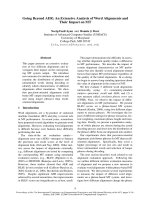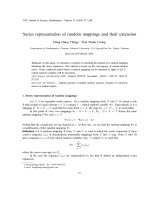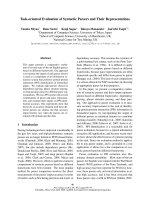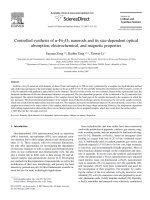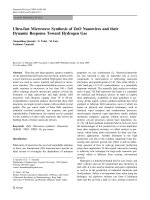Synthesis of functional nanocomposites and their bio imaging applications
Bạn đang xem bản rút gọn của tài liệu. Xem và tải ngay bản đầy đủ của tài liệu tại đây (8.08 MB, 182 trang )
SYNTHESIS OF FUNCTIONAL NANOCOMPOSITES
AND THEIR BIO-IMAGING APPLICATIONS
SHENG YANG
NATIONAL UNIVERSITY OF SINGAPORE
2013
SYNTHESIS OF FUNCTIONAL NANOCOMPOSITES AND
THEIR BIO-IMAGING APPLICATIONS
SHENG YANG
(B. Eng., Nanjing Univ. of Aeronautics and Astronautics)
A THESIS SUBMITTED
FOR THE DEGREE OF DOCTOR OF PHILOSOPHY
DEPARTMENT OF MATERIALS SCIENCE & ENGINEERING
NATIONAL UNIVERSITY OF SINGAPORE
2013
To my family
To our youth which eventually fades away
i
Acknowledgement
There are many people I would like to thank for their support and help during my Ph.D.
study. I would like to take this opportunity to appreciate their help.
Firstly, I would like to express my earnest gratitude to my supervisor Dr. Xue Jun Min for
his excellent guidance, invaluable advices, enthusiastic encouragement and inspiration
throughout the course of my research. The research progress was very tough in my first
two years study. I must thank you for responding so positively to all my bad experimental
results. I deeply appreciate all your contributions of time, ideas to make my Ph.D.
experience both productive and stimulating.
I would also like to thank the entire team of lab technologists in the Advanced Materials
Characterization Laboratory in my department for maintaining the machine in good
condition and creating such good research atmosphere. I thank Serene Chooi for
coordinating the safety of the labs. I thank Mr. Chan for helping purchasing chemicals. I
thank Mdm. He Jian for providing a clean and tidy biological lab for my cell assays. I
thank Agnes for all her help for the Zetasizer. I thank Chen Qun for his assistance on my
XRD and VSM experiments. I thank Yeow Koon for all his help on FT-IR and UV-Vis
experiments. I thank Henche for all his help on the XPS experiments. I thank Roger for
maintaining the smooth running of our wet-lab.
I would also like to thank Dr. Zhang Jixuan of the TEM lab for all her assistance,
guidance in the use of the TEM equipment. No matter how bad my result was, it was
always a good time working with you.
ii
To Dr. Eugene Shi Guang Choo, Mr. Tang Xiaosheng, Yuan Jiaquan, Li Meng, Chen Yu,
Erwin and Vincent Lee of the Nanostructured Biomedical Materials Lab. I appreciate all
the help and valuable suggestions on my research work, helping me walk through my
tough days. I am also grateful for all the meal gatherings that were organized within our
group. I had a great time working and chilling out with y’all!
I also would like to thank my close friends: Dr. Yuan Du, Dr. Wang Yu, Dr. Liu Huajun,
Dr. Sun Kuan, Dr. Yang Yang, Mdm. Bao Nina, Mdm. Ran Min, Mr. Li Ling, Mdm. Liu
Yanqiong, Mr. Huang Qizhao, and Mr. Wang Sibao. Thank you all for your support and
encouragement during my life as a research student. May the Force be with you.
iii
Abstract
In this thesis, the study was aimed at the investigation on the fabrication approaches,
magnetic and optical properties, as well as the performances on the in vitro bio-imaging
applications of the functional nanocomposites. To realize the satisfied performance and
uniformity of the nanocomposites, the preparation of such materials was divided into two
parts: synthesizing hydrophobic functional nanoparticles and subsequent encapsulation
by protecting materials. To date, synthesizing nanoparticles by using pyrolysis route such
as thermal decomposition method is still the most popular one because it is convenient
and advantageous to control the size, composition, and properties of the nanoparticles. As
a result, monodispersed magnetic and optical nanoparticles were successfully obtained in
this study. The characterization of these nanoparticles showed that they had well
controlled structure and properties.
In order to prepare these nanoparticles for biomedical applications, proper surface
modification is required to transfer the nanoparticles into water phase and to enhance
their biocompatibility. Surface coating route using inert materials such as silica, graphene
oxide and gold was chosen rather than simple ligand exchange route in this investigation
because coating extra shell not only transfer hydrophobic nanoparticles into aqueous
phase, but also improve colloidal stability, biocompatibility, as well as resistance against
erosion.
These nanocomposites were also broadly characterized in terms of size,
morphology, colloidal stability, composite structure, as well as magnetic and optical
properties. In this study, the nanocomposites fabricated by using encapsulation route
were controlled between 10 to 100 nm in dimension, which could favor biomedical
iv
applications in a wide range of conditions, especially in in vivo applications. It was also
found that the functional magnetic nanocomposites and optical nanocomposites using
such surface coating methods can reach magnetization as high as 11.1 em·μg
-1
for
MnFe
2
O
4
@SiO
2
nanoparticles and quantum yield as high as 27% for yellow emitting
AIZS-GO nanocomposites, respectively. These outstanding properties of the obtained
nanocomposites ensured their success in in vitro applications demonstrated in this thesis.
Besides, the nanocomposites could be conveniently further surface functionalized by
utilizing the surface functional groups such as –NH
2
or –COOH to conjugate necessary
molecules. Moreover, the cytotoxicity assay of these nanocomposites demonstrated low
cytotoxic effect upon NIH/3T3 mouse embryonic fibroblast cells due to the protection
from the shell or the materials encapsulated the functional nanoparticles.
v
Table of Content
Acknowledgement i
Abstract iii
Table of Content v
List of Publications viii
List of Tables ix
List of Figures x
List of Abbreviations xvii
Chapter 1 Introduction 1
1.1 Overview of Inorganic Nanoparticles and Their Bio-imaging Applications 1
1.2 Brief Introduction to Magnetic Resonance Imaging (MRI) 3
1.3 Brief Introduction to Cellular Imaging 6
1.4 Synthesis and Properties of Inorganic Nanoparticles 9
1.4.1 Magnetic Nanoparticles 9
1.4.2 Quantum Dots 15
1.5 Review of Major Surface Modification Techniques 20
1.5.1 Ligand Exchange 21
1.5.2 Surface Coating 23
1.6 Motivation and Objectives 33
1.6.1 Motivation 33
1.6.2 Objectives 36
1.7 References 37
Chapter 2 Characterization Techniques and Cell Cultivation 45
2.1 Structural Characterization 45
2.1.1 X-ray Diffraction (XRD) 45
2.1.2 Transmission Electron Microscopy (TEM) 46
2.1.3 Fourier Transform Infrared Spectroscopy (FT-IR) 47
2.1.4 Dynamic Light Scattering Spectrometer (DLS) 47
2.1.5 X-ray Photoelectron Spectroscopy (XPS) 48
2.1.6 Atomic Force Microscopy (AFM) 48
2.1.7 Thermogravimetric Analysis (TGA) 49
2.2 Magnetic Property Characterization 49
2.2.1 Vibrating Sample Magnetometer (VSM) 49
2.3 Optical property characterization 50
2.3.1 UV-visible-IR Spectroscopy 50
2.3.2 Photoluminescence Spectrometer (PL) 51
2.4 Cell Culture Preparation 51
2.5 Cellular Up-take 51
2.6 References 53
vi
Chapter 3 Synthesis of Silica Coated Magnetic Nanoparticles for Dual-mode Bio-
imaging and Magnetic Hyperthermia 54
3.1 Introduction 54
3.2 Experimental Procedures 56
3.3 Results and Discussion 60
3.3.1 Synthesis of Hydrophobic Magnetic Nanoparticles 60
3.3.2 Phase Transfer and Silica Coating of Nanoparticles 63
3.3.3 Magnetic Property of Hydrophobic Nanoparticles and Silica Coated
Nanoparticles 67
3.3.4 Magnetic Resonance Imaging (MRI) and Magnetic Hyperthemia of
MnFe
2
O
4
Nanoparticles 70
3.3.5 PEGylation, Colloidal Stability and Cytotoxicity Assay of Silica Coated
MnFe
2
O
4
Nanoparticles 72
3.4 Summary 76
3.5 References 77
Chapter 4 Synthesis of Silica Coated Zinc-doped AgInS
2
Nanoparticles for in vitro
Cellular Imaging 80
4.1 Introduction 80
4.2 Experimental Procedures 81
4.3 Results and Discussion 86
4.3.1 Synthesis of Zinc-doped AgInS
2
Nanoparticles 86
4.3.2 Phase Transfer and Silica Coating of AIZS Nanoparticles. 89
4.3.3 Photophysical Properties of AIZS Nanoparticles and AIZS/SiO
2
Nanoparticles 94
4.3.4 PEGylation of AIZS/SiO
2
Nanoparticles 98
4.3.5 Cytotoxicity Assay and in vitro Cellular Imaging Demonstration 100
4.4 Summary 101
4.5 References 102
Chapter 5 Graphene Oxide Based Fluorescent Nanocomposites for in vitro Cellular
Imaging 104
5.1 Introduction 104
5.2 Experimental Procedures 107
5.3 Results and Discussion 111
5.3.1 Preparetion of Graphene Oxide Nano Sheets 111
5.3.2 Preparation of Zinc-doped AgInS
2
Nanoparticles 116
5.3.3 Preparation of AIZS-GO Nanocomposites 118
5.3.4 Photophysical Properties of AIZS-GO Nanocomposites 126
5.3.5 PEGylation and Colloidal Stability of AIZS-GO Nanocomposites 128
5.3.6 Cytotoxicity Assay and in vitro Cellular Imaging 131
5.4 Summary 134
5.5 Reference: 135
vii
Chapter 6 Synthesis and Properties of Heterostructured Au-Fe
3
O
4
Nanoparticles 137
6.1 Introduction 137
6.2 Experimental Procedures 139
6.3 Results and Discussion 141
6.3.1 Influence of 1, 2-Hexadecanediol on the Synthesis of Heterostructured
Au-Fe
3
O
4
Nanoparticles 141
6.3.2 Structural Characterization of the Heterostructured Au-Fe
3
O
4
Nanoparticles 144
6.3.3 Morphology Investigation of Heterostructured Au-Fe
3
O
4
Nanoparticles
146
6.3.4 Surface Plasma Resonance and Magnetic Properties of Heterostructured
Au-Fe
3
O
4
Nanoparticles 148
6.3.5 Phase Transfer of the Heterostructured Au-Fe
3
O
4
Nanoparticles and
Subsequent Seeded Growth 150
6.4 Summary 153
6.5 References 154
Chapter 7 Conclusion and Possible Future Work 156
7.1 Conclusion 156
7.2 Possible Future Work 159
7.3 References 160
viii
List of Publications
Yang Sheng, Xiaosheng Tang, Erwin Peng, Junmin Xue, “Graphene Oxide Based
Fluorescent Nanocomposites for Cellular Imaging”, Journal of Materials Chemistry B, 1
(2013), 512.
Yang Sheng, Xiaosheng Tang, Junmin Xue, “Synthesis of AIZS@SiO
2
Core Shell
Nanoparticles for Cellular Imaging Applications”, Journal of Materials Chemistry, 22
(2012), 1290.
Yang Sheng, Junmin Xue, “Synthesis and Properties of Au-Fe
3
O
4
Heterostructured
Nanoparticles”, Journal of Colloid and Interface Science, 374 (2012), 96.
Eugene Shi Guang Choo, Xiaosheng Tang, Yang Sheng, Borys Shuter, and Junmin Xue,
"Controlled Loading Of Superparamagnetic Nanoparticles in Fluorescent Nanogels as
Effective T
2
-weighted MRI Contrast Agents", Journal of materials chemistry, 21 (2011),
2310.
Jiaquan Yuan, Eugene Shi Guang Choo, Xiaosheng Tang, Yang Sheng, Jun Ding, Junmin
Xue, “Synthesis of ZnO-Pt Nanoflowers And Their Photocatalytic Applications”,
Nanotechnology, 21 (2010), 185606.
Erwin Peng, Eugene Shi Guang Choo, Yang Sheng, and Jun Min Xue, “Monodisperse
Transfer of Superparamagnetic Nanoparticles from Non-polar Solvent to Aqueous Phase”,
New Journal of Chemistry (Accepted)
Xiaosheng Tang, Yang Sheng, Yu Chen, Gregory K.L. Goh, Junmin Xue; “Control
synthesis of AgInS
2
-ZnS Alloyed Nanorod from AgInS
2
Nanoparticles to AgInS
2
-ZnS
Heterodimer” Submitted
ix
List of Tables
Table 2-1 Instruments used for characterizations. 45
Table 5-1 Summary of basic characteristics of the AIZS-GO nanocomposites. 127
x
List of Figures
Figure 1-1: Principle of magnetic resonance. (a) Spin aligns parallel to the external
magnetic field and precess under Larmor frequency ω
0
. (b) After RF
pulse, the direction of spin changes. (c) Spin undergoes relaxation
process, generating T
1
and T
2
signals. 4
Figure 1-2: (a) Schematic showing the determination of T
1
due to recovery of
longitudinal magnetization. (b) Schematic showing the determination of
T
2
due to dephasing of the spin precessions. 5
Figure 1-3: Simplified energy diagram for electron excitation and photon emission in
semiconductors. 6
Figure 1-4: Illustration and comparison of absorption (dashed line) and emission (solid
line) spectra, and stokes shift of (a) organic dye and (b) QDs. 7
Figure 1-5: Schematic illustration of the formation of iron oxide nanoparticles via
thermal decomposition method in a heating up process. 11
Figure 1-6: (a) An unmagnetized magnetic material in the absence of an applied
magnetic field. Domains A and B are the same size and have opposite
magnetizations. (b) When an external magnetic field is applied the
domain wall migrates towards right side. The result is that the specimen
now acquires net magnetization. 13
Figure 1-7: (a) Illustration of stages of nucleation and growth for preparation of QDs
via hot injection technique. (b) Simple synthetic apparatus set-up
employed in the preparation of hydrophobic QDs via hot injection
technique. 16
Figure 1-8: (a) Illustration of band structure of inorganic semiconductor as bulk
material, nanocrystal and atom. (b) Schematic depiction of band diagram
of QDs and corresponding electron transition between CB and VB upon
excitation. 18
Figure 1-9: Illustration of phase transfer using ligand exchange approach. The original
hydrophobic ligands are completely replaced by hydrophilic ligands. 22
Figure 1-10: Illustration of phase transfer using polymer coating approach. The
original ligands are reserved and the amphiphilic polymer with
xi
hydrophobic backbone is coated as an extra layer via hydrophobic
interaction. 25
Figure 1-11: Illustration of phase transfer using silica coating approach via hydrolysis
of TEOS. Silica is coated as an extra shell protecting the inner core. 27
Figure 3-1: TEM images of Fe
3
O
4
nanoparticles with an average size 10 nm (A) and
14 nm (B). Insets: high resolution TEM images (left) and SAED patterns
(right) of corresponding samples. (C) XRD pattern of the corresponding
Fe
3
O
4
nanoparticles. 60
Figure 3-2: TEM images of MnFe
2
O
4
nanoparticles with an average size 10 nm (A)
and 14 nm (B). Insets: high resolution TEM images (left) and SAED
patterns (right) of corresponding samples. (C) The XRD pattern of the
corresponding MnFe
2
O
4
nanoparticles. 61
Figure 3-3: Schematic illustration of the procedure for synthesizing silica coated
magnetic nanoparticles. 63
Figure 3-4: TEM images of Fe
3
O
4
nanoparticles phase transferred by using CTAB
dispersed in H
2
O. 64
Figure 3-5: TEM images of silica nanoparticles prepared by using different
concentration of NaOH with identical concentration of Fe
3
O
4
nanoparticles. (A) 12 mM, (B) 8 mM, (C) 4 mM. 65
Figure 3-6: TEM images of Fe
3
O
4
nanoparticles with different silica shell thickness,
(A, B) 30 nm; (C, D) 18 nm; (E, F) 10 nm; (G, H) 5 nm. (J, K) TEM
images of MnFe
2
O
4
nanoparticles with 10 nm silica shell. 66
Figure 3-7: (A) VSM profile of 9 nm and 14 nm Fe
3
O
4
nanoparticle. (B) High
resolution VSM profile of 9 nm and 14 nm Fe
3
O
4
nanoparticles. Inset:
photos of a ferrofluid of Fe
3
O
4
nanoparticles dissolved in hexane before
(left) and after (right) the magnetic field is applied. 67
Figure 3-8: (A) VSM profile of 10 nm and 14 nm MnFe
2
O
4
nanoparticle. (B) High
resolution VSM profile of 10 nm and 14 nm MnFe
2
O
4
nanoparticles.
Inset: photos of a superparamagnetic fluid of MnFe
2
O
4
nanoparticles
dissolved in hexane before (left) and after (right) the magnetic field is
applied. 68
xii
Figure 3-9: Magnetic properties of Fe
3
O
4
nanoparticles with different silica shell
thickness of 30 nm, 20 nm, 10 nm and MnFe
2
O
4
nanoparticles with 10
nm silica shell thickness. 69
Figure 3-10: (A) Plot of T
2
relaxation rate (1/T
2
) against iron concentration at 25 °C.
(B) Time dependent temperature curve of 1 mL of 0.1 mg Fe mL
-1
MnFe
2
O
4
@SiO
2
nanoparticles under exposure of 41.98 KA/m field at
240 kHz frequency. 71
Figure 3-11: EDS data of 14 nm hydrophobic MnFe
2
O
4
nanoparticles. Peak label of
irrelevant elements are removed from the image. 72
Figure 3-12: (A) Colloidal stability of MnFe
2
O
4
-SiO
2
-PEG nanoparticles measured at
25 °C and 37 °C in PBS 1× solution, respectively. Inset: hydrodynamic
size of MnFe
2
O
4
-SiO
4
-PEG nanoparticles in DI-H
2
O at 25 °C. (B)
Corresponding TEM image of the obtained MnFe
2
O
4
-SiO
2
-PEG
nanoparticles dispersed in DI-H
2
O. (C) Dose-dependent viability
evaluation of NIH/3T3 cells treated with MnFe
2
O
4
-SiO
2
-PEG
nanoparticles 73
Figure 3-13: (A) photoluminescence spectra of MnFe
2
O
4
-SiO
2
-FITC nanoparticles
(dashed line: excitation spectrum, solid line: emission spectrum). Inset:
MnFe
2
O
4
@SiO
2
-FITC nanoparticles dispersed in DI-H
2
O under room
light (left) and UV light (right) conditions. (B) TEM images of
corresponding MnFe
2
O
4
@SiO
2
-FITC nanoparticles. (C) Merged CLSM
image of NIH/3T3 cells stained by MnFe
2
O
4
@SiO
2
-PEG nanoparticles.
Inset: High resolution fluorescent image of two typical NIH/3T3 cells. 75
Figure 4-1: Schematic illustration of procedure for synthesizing AIZS/SiO
2
core/shell
nanoparticles. 82
Figure 4-2: XRD patterns of Zinc doped AgInS
2
nanoparticles with red(I), orange(II),
yellow(III) and green(V) emissions. 86
Figure 4-3: EDS of AIZS nanoparticles. Inset: element ratio between Ag, In and Zn in
AIZS nanoparticles with red, orange, yellow and green emissions. 87
Figure 4-4: TGA curve for AIZS nanoparticles with red emission. 88
Figure 4-5: TEM image of the AIZS nanoparticles with green (A), yellow (B), orange
(C), and red (D) emissions dispersed in hexane. 89
xiii
Figure 4-6: (A) AIZS nanoparticles with red emission dispersed in hexane. Inset: HR-
TEM of one typical AIZS nanoparticle with red emission (top right).
Histogram calculated from the TEM image of corresponding AIZS
nanoparticles (bottom right). (B) AIZS nanoparticles with red emission
after phase transferred by CTAB dispersed in DI-H
2
O. 90
Figure 4-7: TEM images of AIZS/SiO
2
core shell nanoparticles with (A) green, (C)
yellow, (E) orange, and (G) red emitting AIZS cores, dispersed in DI-
H
2
O. Insets in (D, E, F) are histograms calculated from the TEM images.
(B), (D), (F) and (H) showing the TEM images of their corresponding
one typical AIZS/SiO
2
nanoparticles. 91
Figure 4-8: TEM images at different resolutions of silica coated AIZS clusters
synthesized with highly concentrated AIZS nanoparticles during CTAB
phase transfer. 92
Figure 4-9: Mesoporous silica nanoparticles prepared by rinsing with 0.1M (A) and
0.05M (B) HCl solution. Note that in TEM image A, almost all AIZS
nanoparticles are dissolved by HCl. Inset: the pore size distribution
calculated from TEM measurements. Red arrow in (B) indicates missing
of AIZS core in silica nanoparticles after 0.05M HCl rinsing. A hole can
be observed. 93
Figure 4-10: (A) PL spectra of AIZS nanoparticles dispersed in hexane. Inset is
photograph of AIZS nanoparticles with different color emissions
illuminated by UV lamp. (B) PL spectra of AIZS/SiO
2
nanoparticles with
different color emissions. Inset is photograph of AIZS/SiO
2
nanoparticles
illuminated by UV lamp 94
Figure 4-11: (A) Change in PL spectrum of the AIZS nanoparticles (orange emission)
in CTAB micelles during four days storage in ambient room environment.
Insets are photos of samples taken at three different time periods,
illuminated by UV lamp. (B) PL spectra of AIZS/SiO
2
nanoparticles with
orange emission in water at time 0 and time 96 h. Insets are the emission
intensity and peak position record at periodic time interval. The inset
photo demonstrates red the red emission of the AIZS nanoparticles after
silica coating, illuminated by UV lamp. 96
Figure 4-12: FT-IR spectra of pure commercial mPEG-NHS (I), aminated AIZS/SiO
2
(II) and PEGylated AIZS/SiO
2
(III). 98
Figure 4-13: (A) DLS measurements of PEGylated AIZS/SiO
2
nanoparticles in
mediums DI-H
2
O, PBS and BCS solution. The measurements were
carried out at 37℃. (B) TEM image of PEGylated AIZS/SiO
2
dispersed
xiv
in ethanol and dried on copper grid. (C) Dose-dependent viability
evaluation of NIH/3T3 cells treated with AIZS/SiO
2
-PEG nanoparticles.
(D) Fluorescent image of Hela cells tagged with AIZS/SiO
2
nanoparticles
with red emission under UV excitation. 100
Figure 5-1: Schematic illustration of the procedure for synthesizing fluorescent AIZS-
GO nanocomposites. 106
Figure 5-2: (A) AFM image of the obtained GO (Inset: XRD pattern of the
corresponding GO). (B) Section Analysis of one piece of GO sheet. 111
Figure 5-3: XPS spectra of GO (C 1s) (A) and oleyamine modified GO (C 1s) (B). (C)
XPS spectrum of OAM-GO sheets. (D) XPS spectrum GO (N 1s). 113
Figure 5-4: FT-IR spectra for GO (i), OAM-GO (ii), AIZS nanoparticles (iii), AIZS-
GO nanocomposites (iv), and AIZS-GO-PEG nanocomposites (v). 114
Figure 5-5: TEM images of AIZS nanoparticles with green (A), yellow (B), orange (C)
and red (D) emissions. 116
Figure 5-6: XRD patterns of AIZS nanoparticles with green, yellow, orange and red
emissions, respectively 117
Figure 5-7: (A) TEM image of the as-synthesized AIZS-GO nanocomposites with red
emission (Inset: TEM image of one AIZS-GO nanocomposite). The GO
sheets were not observable in the images due to the low contrast. B)
AFM image of corresponding AIZS-GO nanocomposites (Inset: DLS
measurement of the corresponding AIZS-GO nanocomposites). C) High-
resolution AFM of the AIZS-GO nanocomposites. 118
Figure 5-8: (A) Excitation spectra of AIZS nanoparticles dispersed in hexane (black
line) and AIZS-GO nanocomposites dispersed in H
2
O (red line). Inset:
photograph of red emitting AIZS nanoparticles and AIZS-GO
nanocomposites under room light (right) and UV lamp irradiation (left)
conditions. (B) XRD pattern of the corresponding sample. 119
Figure 5-9: (A) Photograph of red emitting AIZS-GO nanocomposites aqueous
suspension under room light (top) and UV lamp irradiation (bottom)
conditions. (B) Photoluminescence spectra of the corresponding samples
suspended in DI-H
2
O 120
Figure 5-10: TEM images of samples RGO-1, RGO-2, RGO-3 and RGO-4 (insets: the
corresponding DLS measurements). 122
xv
Figure 5-11: TEM images of AIZS-GO nanocomposites with (A) green, (D) yellow,
(G) orange, and (J) red emissions in DI-H
2
O. (B), (E) (H) and (K)
showed the TEM images of one AIZS-GO nanocomposite with orange,
yellow, and green emissions, respectively. (C), (F) (I) and (C) were their
corresponding DLS measurements. The GO sheets were not observable
in the images due to the low contrast. 124
Figure 5-12: (A) The photoluminescence spectra of AIZS nanoparticles suspended in
hexane (Inset: photograph of the corresponding AIZS nanoparticles
under UV lamp irradiation). (B) The photoluminescence spectra of
AIZS-GO nanocomposites suspended in DI-H
2
O (Inset: photograph of
corresponding AIZS-GO nanocomposites under UV lamp irradiation).
126
Figure 5-13: A) Colloidal stability of AIZS-GO-PEG nanocomposites measured at
25°C and 37ºC in DI-H
2
O and PBS solution, respectively. B) TEM
image of AIZS-GO-PEG nanocomposites dispersed in DI-H
2
O (Inset:
one typical AIZS-GO-PEG nanocomposite). 129
Figure 5-14: (A) Dose-dependent cell viability evaluation of NIH/3T3 cells treated
with AIZS-GO-PEG nanocomposites at different concentrations. (B)
Fluorescent image and (C) merged image of NIH/3T3 cells tagged with
red emitting AIZS-GO-PEG nanocomposites. (D) High resolution bright
field image, (E) fluorescent image and (F) merged image of NIH/3T3
cells at high resolution. (scale bars: 20µm). 131
Figure 5-15: Fluorescent images (A, D), merged images (B, E), and bright field
images (C, F) of NIH/3T3 cells tagged with yellow emitting AIZS-GO-
PEG nanocomposites. 132
Figure 5-16: CLSM images (A) and merged images (B) of one typical NIH/3T3 cell
tagged with yellow color emitting AIZS-GO-PEG nanocomposites at
different cross-sections (1 µm interval), illustrating the distribution of
fluorescent nanocomposites in cell. Images were taken from the bottom
to the top of the cell at a step of 0.5 µm. It could be clearly seen that the
fluorescent nanocomposites were accumulated in cytoplasm around the
nuclei (scale bars: 10µm). (C) 3D image of one cell tagged with yellow
emitting AIZS-GO-PEG nanocomposites. 133
Figure 6-1: TEM images of samples synthesized with different concentration of 1,2-
hexadecanediol (HDD). (A) 0M; (B) 0.3M; (C) 0.6M; (D) 1.2M. 141
xvi
Figure 6-2: (A) TEM image of the precipitate collected from the synthesis without
HDD. (B) Corresponding magnetization at room temperature. (C)
Corresponding XRD pattern of the precipitate. 143
Figure 6-3: (A) TEM image of the Au-Fe
3
O
4
hetero-dimers synthesized with 0.6M
HDD and 2mmol Fe(CO)
5
. (B) HRTEM of one typical 3.5-9 nm Au-
Fe
3
O
4
hetero-dimer. (C) XRD pattern of Au-Fe
3
O
4
hetero-dimers. The
identical peaks and indices of bulk Fe
3
O
4
(black bar) and bulk Au (red
bar) are indicated in the diagram. (D) SAED pattern of the same sample.
144
Figure 6-4: The EDS spectrum of the obtained Au-Fe
3
O
4
hetero-dimers synthesized
with 2mmol Fe(CO)
5
and corresponding elemental analysis. 145
Figure 6-5: TEM images of Au-Fe
3
O
4
hetero-dimers with different domain sizes. (A)
4.5-5 nm Au-Fe
3
O
4
nanoparticles (Sample I). (B) 3.5-9 nm Au-Fe
3
O
4
nanoparticles (Sample II). (C) 3.5-12 nm Au-Fe
3
O
4
nanoparticles
(Sample III). Insets: histograms showing the size distribution of Au and
Fe
3
O
4
domains of corresponding sample. (D) XRD patterns of the
samples synthesized with different doses of Fe(CO)
5
: I: 1mmol; II:
2mmol; III: 3mmol. 146
Figure 6-6: (A) UV-Vis absorption spectra of samples: I, II, III, pure Au nanoparticles,
and pure Fe
3
O
4
nanoparticles, respectively. All samples were suspended
in hexane. 148
Figure 6-7: Magnetization as a function of applied field for the samples I, II, III at
room temperature. (B) The magnetization-field curves at low applied
field for the samples synthesized with different doses of Fe(CO)
5
at room
temperature: I: 1mmol; II: 2mmol; III: 3mmol. 149
Figure 6-8: UV-Vis absorbance spectra of Au-Fe
3
O
4
hetero-dimers before (suspended
in hexane, solid line) and after phase transfer (suspended in DI-H
2
O,
dashed line). 150
Figure 6-9: (A, B) TEM images of the star-like Au-Fe
3
O
4
nanocomposites synthesized
from seeded growth method. 151
Figure 6-10: UV-Vis absorption spectrum of the star-like nanocomposites synthesized
with seeds volume 1000 μL, 100 μL, 50 μL, and 10 μL, respectively. 152
Figure 7-1: (A) TEM images of MnFe
2
O
4
nanoparticles with mesoporous silica shell.
(B) N
2
adsorption/desorption isotherms (inset: pore size distribution from
adsorption branch; V=pore volume, D=pore size). 160
xvii
List of Abbreviations
AFM Atomic force microscopy
APTS (3-Aminopropyl)triethoxysilane
BCS Bovine calf serum
CTAB Cetrimonium bromide
DLS Dynamic light scattering spectrometer
EDS Electron diffraction spectroscopy
FITC Fluorescein isothiocyanate
FT-IR Fourier transform infrared
DMEM Dulbecco's Modified Eagle Medium
GO Graphene oxide
HDD 1,2-Hexadecanediol
MRI Magnetic resonance imaging
NIR Near infrared
OAM Oleylamine
PBS Phosphate buffered saline
PEG Poly(ethylene glycol)
PL Photoluminescence
SAR Specific absorption rate
SAED Selected area electron diffraction
SPR Surface Plasmon Resonance
TEM Transmission electron microscopy
TEOS Tetraethyl orthosilicate
xviii
TGA Thermogravimetric analysis
TEM Transmission electron microscopy
UV-Vis UV-visible-IR Spectroscopy
VSM Vibrating sample magnetometer
XPS X-ray photoelectron spectroscopy
XRD X-ray diffraction
1
Chapter 1 Introduction
1.1 Overview of Inorganic Nanoparticles and Their Bio-imaging
Applications
Nanoparticles have received tremendous research interest in the past decades. These
extremely small particles ranging from several to a few hundred nanometers demonstrate
diverse performance in the physical, chemical and biological properties from their bulk
counterpart. These novel properties promise the nanoparticles a broad perspective future
in the field of biomedicine. On the other hand, there is a quickly increasing demand on
bio-nanotechnology in medical product market, which includes nanomedicine,
nanodiagnostic, and nanotech-based medical supplies and devices. The market demand
for nanotechnology medical products is valued to reach $21 billion in 2012, and even
doubled in 2017. [1] In the regime of nano-diagnositic, the fast development of a variety
of novel nanoprobes and biosensors significantly improves the accuracy and efficiency of
current diagnostic imaging techniques such as magnetic resonance imaging (MRI),
fluorescent imaging and optical coherence tomography (OCT), etc. [2-4] It is thus of
great interest to understand how the nanoparticles gain such fascinating properties which
never appear with their bulk counterpart, as well as how they are applied to the clinical
diagnostic application.
As indicated by its name, the key point about nanomaterial is the size. When the
dimension of a material is only a few hundred nanometers or even smaller, it is
considered as a nanomaterial. At this size range, the surface area to volume ratio, the
2
density of electrons, and a lot of other attributes become so different that the magnetic,
optical and electronic properties will change. The further explanation of size effect on the
properties will be discussed in the following sections.
Not only the properties of material, but also the interaction between an object and
the physiological system is greatly influenced by the size. In order to be successfully
transported within vascular systems, the size of the object should have a diameter
between 10 nm to 2 µm, depending on the pores or the opening of the tissue. However,
molecules or particles smaller than 5 nm can be rapidly cleared out from the bloodstream
by renal filtration, [5] while those micro-sized particles will be removed from the
bloodstream by the reticuloendothelial system (RES) through opsonization. Therefore
nanomaterials between 10 nm to 500 nm can circulate within the vascular system long
enough to reach and accumulate at the target sites. [6] In addition, there is a particular
concern about the long-term exposure of nanomaterials in tissue or body system.
Therefore a delicate balance between circulation time for particles to reach the target site
and suitable time for their elimination has to be achieved by sophisticatedly design the
dimension as well as the surface decoration of the particles.
Although the rapid development of the synthesis of nanoparticles in recent years
achieved to prepare nanoparticles made of different materials with well controlled size,
structure and properties, it is still challenging to successfully modify and functionalize
the nanoparticles, which is the linking bridge between the nanoparticles and their
biomedical applications. Especially for those nanoparticles synthesized from oil phase,
the step of phase transfer is very critical in order to make these water-insoluble
nanoparticles soluble in water phase.
3
At present MRI and optical imaging are two types of the most attractive
diagnostic techniques which closely relate to functional nanoparticles. Paramagnetic
materials such as Gd and Mn chelated contrast agent are designed for the purpose of T
1
-
weighted MRI while superparamagnetic or ferromagnetic iron oxide nanoparticles can be
applied to T
2
-weighted MRI. The MRI result can gain more precise diagnosis by
enhancing the image contrast. Optical imaging is another popular technique to acquire
diagnostic information based on collecting the light signal from the sample. Ultrasmall
semiconductor nanoparticle, also known as quantum dot (QD), is one of the widely used
fluorescent labeling agents for this purpose. Nevertheless, the concern on the
environmental and cytotoxic effect from these traditional Cd or Pb based QD
significantly limits the clinical applications. Recent advances in pursuing alternative Cd-
free QD have made significant stride so that there is a broad perspective for applying
QDs for optical imaging.
1.2 Brief Introduction to Magnetic Resonance Imaging (MRI)
Nowadays, MRI diagnosis is one of the most widely used non-invasive imaging
modalities preferred for detecting diseases of the brains, spine and musculoskeletal
system. [7, 8] Modern clinical MRI technique is based on nuclear magnetic resonance
(NMR) signal form protons (
1
H) of water molecules generated by the co-operation of a
strong static magnetic field and a transverse radio frequency (RF) pulse. In practice, all
spins of these protons are aligned with the direction of the imposing external strong static
magnetic field (B
0
) before the RF pulse is applied. When RF pulse is applied to disturb
the situation, the spins of these protons tilt away from their equilibrium states and begin
4
to precess about the direction of B
0
(Figure 1-1a). The angular frequency of precession is
called Larmor frequency (ω
0
).
00
B
, Eq. 1-1
where γ is the gyromagnetic ratio of nuclei. The frequency of the RF pulse in practical set
up equals to the Larmor frequency and the pulse is perpendicular to the longitudinal axis
(B
0
) because at this frequency the RF pulse can produce resonant interaction with the
nuclei. After the RF pulse, the spins of the protons are at high energy states and therefore
begin to re-align with the direction of B
0
as protons attempt to recover to equilibrium
under strong static magnetic field, which is called relaxation (Figure 1-2b, c). During this
relaxation process, signal is generated and collected by RF receiver.
Figure 1-1: Principle of magnetic resonance. (a) Spin aligns parallel to the external
magnetic field and precess under Larmor frequency ω
0
. (b) After RF pulse, the direction
of spin changes. (c) Spin undergoes relaxation process, generating T
1
and T
2
signals.
The relaxation can be classified into two independent processes: longitudinal
relaxation and transverse relaxation. Longitudinal relaxation is a spin-lattice (T
1
)
relaxation which represents the recovery of the magnetization vector (spin of protons) in
alignment with B
0
. This relaxation process is caused by the energy loss from the excited
protons to the surrounding lattice. The recovery time is characterized as T
1
, which is

